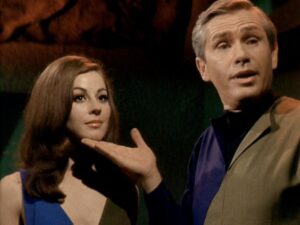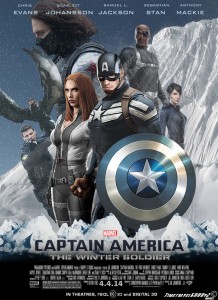.
Star Trek: Strange New Worlds‘ reinterpretation of legacy characters from the original series has certainly intrigued me. I find I am most fascinated by the new version of Nurse Christine Chapel. Jess Bush’s portray of this Christine, along with a more detailed and varied backstory and motivation has placed her as one of my favorites in this new series. No slight to Mrs. Barrett-Roddenberry, she was given precious little to work with in the original series. Beyond pining for Spock her role possessed no character.
Except of course for episode eight, or seven depending on how you count them, season one What Are Little Girls Made Of?
 First aired in October of 1966 the episode centers of the Enterprise searching for the lost humanitarian scientist Dr. Roger Korby, coincidentally the fiancé to Christine Chapel. It is revealed that Korby has discovered the ruins of an ancient and now vanished civilization and from their remaining technology can produce android nearly indistinguishable from humans. He has a nefarious plot and by the end of the episode is defeated and revealed to be an android himself. Fatally injured he had used the technology to transfer himself into a mechanical body a process with which he expected to create practically immortal humans. Kirk and Christine are horrified by the revelation that Korby had been a machine the entire time. When Spock arrives with a rescuing security team Kirk informs him that ‘Dr. Korby was never here.’
First aired in October of 1966 the episode centers of the Enterprise searching for the lost humanitarian scientist Dr. Roger Korby, coincidentally the fiancé to Christine Chapel. It is revealed that Korby has discovered the ruins of an ancient and now vanished civilization and from their remaining technology can produce android nearly indistinguishable from humans. He has a nefarious plot and by the end of the episode is defeated and revealed to be an android himself. Fatally injured he had used the technology to transfer himself into a mechanical body a process with which he expected to create practically immortal humans. Kirk and Christine are horrified by the revelation that Korby had been a machine the entire time. When Spock arrives with a rescuing security team Kirk informs him that ‘Dr. Korby was never here.’
It is an interesting question when did our attitude toward ‘uploading’ ourselves into machines change?
What Little Girls are Made Of spends no time debating if Korby is in fact still Roger Korby. Once it is shown that he is a machine his pleas that he has remained himself fall on the deaf ears of Kirk and Chapel. The premise of the episode is that his actions, plotting to replace people until his android society is too advanced to resist, are accepted as proof that he was never Korby ignoring the simple fact that people change. Or that five years of isolation can unhinge even the strongest of minds. Only the fact that he is a mechanical machine instead of a biological one is enough to ‘prove’ he was never Korby. A machine person will always, at that time, be regarded as a soulless monstrosity.
Today the concept of ‘uploading’ yourself into a tireless and immortal machine housing is pretty much a technological rapture, a promise of eternal, blissful life for the those with faith in the  limitless capability of the computational sciences. In Captain America: The Winter Soldier neither Rogers nor Romanov, or the audience for that matter, question if it really is Dr. Zola addressing them from the vast computer banks at the end of the film’s second act. It is simply accepted that with advanced enough super-science of course a person, the entirety of them transferred into another receptacle. Zola’s monstrosity was a product of who Zola was and not from the mechanical nature of his afterlife.
limitless capability of the computational sciences. In Captain America: The Winter Soldier neither Rogers nor Romanov, or the audience for that matter, question if it really is Dr. Zola addressing them from the vast computer banks at the end of the film’s second act. It is simply accepted that with advanced enough super-science of course a person, the entirety of them transferred into another receptacle. Zola’s monstrosity was a product of who Zola was and not from the mechanical nature of his afterlife.
I wonder when did that state change occur in out collective thinking? When did we accept that it is our memories and sense of continuity that defines the ‘real’ us?
